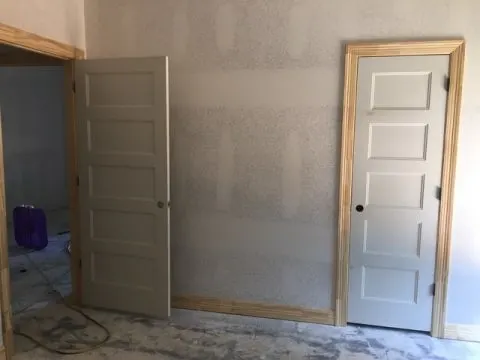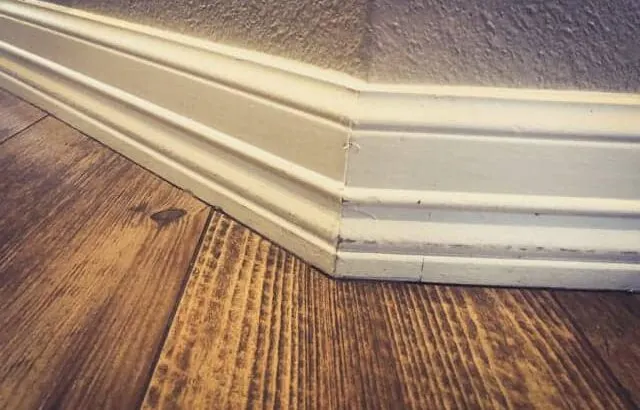Baseboards are an important part of finishing flooring that many home renovators may not consider when they’re trying to plan a project. But baseboards have to be figured into a flooring project whether they’re being replaced along with the flooring or not.
Baseboards are usually installed before flooring with a reservation gap left at the bottom of the baseboards for the flooring to be slid underneath. The gap left under baseboards for flooring is dependent on the width of the flooring being installed.
Baseboards are an important part of flooring installation, and without them, any flooring installed will look cheap and unfinished. Read on to learn more about how to install baseboards to be flush with new flooring.
Do You Install Baseboards or Carpet First?
While it can go either way, when flooring companies install new carpet, they usually install the baseboards on the walls after the carpet is installed.
It’s also possible for the homeowners to install the baseboards before the flooring company comes to install the carpet. In this case, it’s smart to consult with the company to see what height they recommend setting the baseboards.
The flooring company needs to be able to roll the carpet out flush to the edge of the wall, without a rounded baseboard getting in the way. Spacing the baseboard incorrectly can leave the edge of the carpet exposed. One major purpose of the baseboard is to help hide the edge of the carpeting.
Baseboards aren’t just a cosmetic consideration either. Tacking the flooring down under the baseboards helps prevent the carpet from being pulled up.
It also prevents any moisture from getting between the carpet and the subflooring. This installation process is crucial for the prevention of damaging mold and mildew in the home.
Here are some things that determine whether baseboards or flooring are installed first:
- Whether the baseboards are being replaced
- Whether the baseboards are being painted
- What type of new flooring is being installed
- Which company is doing the installation
All remodeling companies are slightly different and have their methods for doing things. As long as the final result is high-quality, the installation order doesn’t matter much in the end.
When Do Baseboards Need to Be Removed?
Existing baseboards may need to be removed to install several kinds of flooring, such as some types of carpet. When new carpeting is installed, the subflooring and foam underneath the carpet are removed too.
Because the baseboards will usually need to be repositioned anyway, the baseboards are usually removed before this step. (Source: Footprint Floors)
Baseboards are also removed in flooring projects where the baseboards will be renovated along with the flooring to match the new look of the room. There are many different baseboard styles to choose from, and each of these can lend the room a unique aesthetic.
It’s also a good idea to remove baseboards to re-paint them even if they aren’t going to be replaced. Baseboards take some of the most damage and dirt on the whole floor since dirt is often pushed up onto them by brooms and mops.
Without getting cleaned, putting dirty baseboards back over new flooring will only draw attention to how battered and grimy they look. (Source: 50 Floor)
Here are some tips to remove baseboards for flooring installation:
- Make sure to number the baseboards and match them to corresponding walls so that you don’t have to waste time trying to match the lengths of baseboards to different walls when it’s time to put them back.
- Make sure you have a sharp utility knife to slice away the caulk holding the baseboards to the wall. This step will make removing them go more easily and avoid the risk of pulling the top surface off the wall up.
- Make sure to use a crowbar to gently pry the baseboards up to avoid breaking them. Keep in mind that it may be difficult to find a matching replacement for older baseboards if you break one, so breaking one may mean replacing them all if you want them to look good.
- Make sure baseboards are cleaned well before re-painting. Dirt and grime on baseboards can cause the paint to peel up if it gets painted over.
When you’re removing baseboards before you put in new flooring, attention to detail can mean the difference between reusing baseboards and being forced to get new ones.
When Should You Leave Baseboards in Place?
In some cases, baseboards are fixed to the wall so strongly with glue or other adhesives that pulling up the baseboard carries the risk of doing significant damage to the walls themselves.
In older homes especially, this can turn a simple remodeling project into an expensive nightmare.
If the baseboards are fixed to the wall in such a way that removing them is almost impossible, there are ways to work around the problem.
Covering baseboards with painter’s tape after cleaning them can keep them from getting paint from the walls on them, and there are usually ways to adjust the flooring (or your choice of flooring) so that it stays flush with the bottom of the baseboards. Following this process guarantees there is no gap left.

Why Install Baseboards Before Carpet?
One reason that baseboards are usually installed before carpeting is that baseboards typically need to be painted to match the trim of the room.
Any painting is avoided around a new carpet installation if possible, and carpeting usually is the last thing to go in after the walls of the room have already been painted. Wood filler and caulk are also easy to get on the new carpet if baseboards are installed after flooring installation.
It is also easier to set the height of the baseboard without carpeting to lay it over. Otherwise, it can be difficult to level the baseboards against the plush of the carpet.
How High Should You Set Baseboards Before Installing Carpet?
The standard height that most baseboards are installed without flooring is 3/8ths of an inch. This leaves plenty of room for the carpet to be shoved up underneath the edge of the baseboards during installation.
Some carpet installers may ask for a 1/4th inch gap for baseboards. This gives extra space for thicker carpets and padding.
It is easier for flooring installers to trim down a tall piled carpet to fit under a baseboard gap than it is to hide the gap of a baseboard that has been installed too high above the pile of the carpet.
Do Flooring Companies Install Baseboards?
Many flooring companies install baseboards as well as flooring.
Since flooring companies often have the same tools necessary for removing baseboards safely without damaging them as they do for putting down the flooring itself, they are usually a better bet for removing and replacing baseboards than the homeowners.
Flooring companies that install hardwood flooring will usually remove and reinstall baseboards. With wood floors, the baseboards have to be completely flat against the hardwood to avoid any unsightly gaps showing underneath. (Source: Houzz)
How Much Does It Cost to Get Baseboards Installed?
Baseboards cost an average of around $1.56 a square foot to install. (Source: Porch) This price is usually calculated above and beyond the costs of installing flooring.
It’s customary for flooring installers to quote the final cost of baseboard removal and installation before the start of an installation job. This way, homeowners know exactly what they’re getting into before the project begins.
Baseboards Are an Important Part of Flooring
Installing new flooring is an expensive investment for a home or office building. Putting in baseboards and other forms of trim are crucial for setting new flooring off.
Without properly placed, cleaned, and painted baseboards, new flooring can make old walls look worse.
Related Reading: Can Wall Tiles Be Used On The Floor? The Truth Revealed
As a homeowner, I am constantly experimenting with making the structure of my house more energy-efficient, eliminating pests, and taking on DIY home improvement projects. Over the past two decades, my family has rehabbed houses and contracted new home builds and I’ve learned a lot along the way. I share my hard-learned lessons so that you can save time and money by not repeating my mistakes.


Leave a comment
You must be logged in to post a comment.